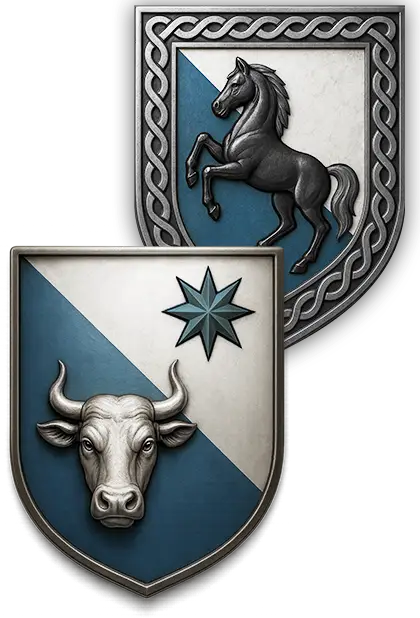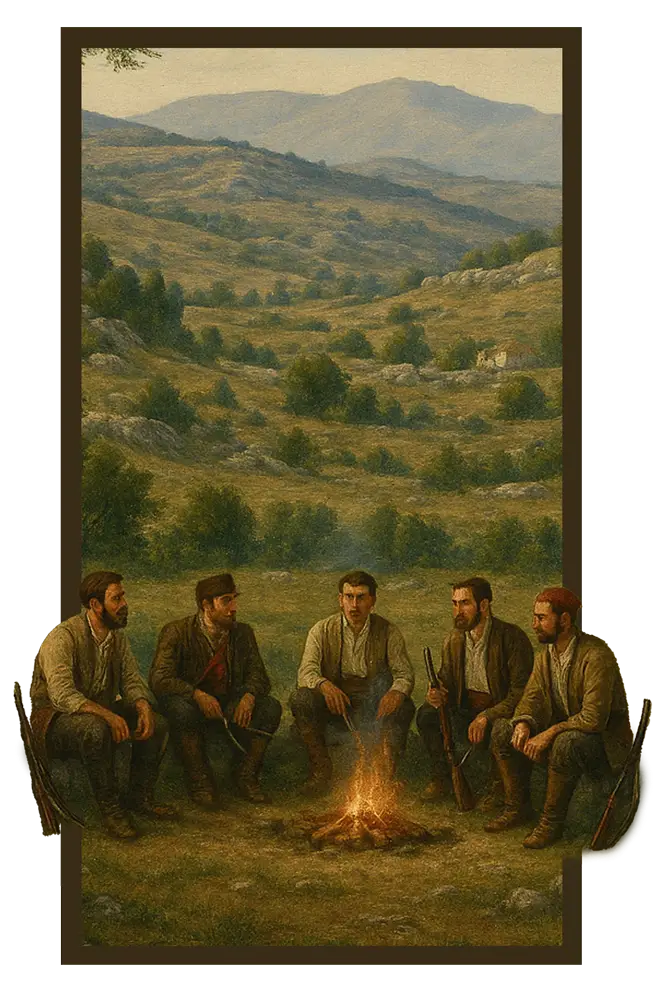From the rocky mountains across the wide world
The "Eljdan" family tree
The beginning of a new branch and a generation between stone and hope
Ilija “Eljdan” Trogrlić and the founding of the Vranjače line
Ilija “Eljdan” Trogrlić, the first settler in Vranjače, was not only a pioneer but also the father of a generation that left a lasting mark on the new beginnings in this remote but fertile region. His nickname “Eljdan” became a byname for entire generations. It is believed to be derived from heljda (buckwheat) – a plant traditionally cultivated in the region. Ilija traded it or planted it himself – like many poor but proud farmers in those years.
In Vranjače, his family was also known as “Eldanović” – a symbolic derivation of the nickname. But they never abandoned the name Trogrlić.

Vranjače – a hidden village in the mountains
The small settlement of Vranjače was first mentioned as an independent place in the register of souls of the Roško Polje parish in 1891. Written evidence of ownership exists since the introduction of the land registry system in Bosnia and Herzegovina, more precisely since the creation of the cadastral maps in 1883. In 1968, the cadastral municipality of Vranjače was officially established as part of the municipal cadastre – with a total area of 14.26 square kilometers.
Vranjače consists of four hamlet groups: Trogrlići, Prke, Šarići (formerly Šarić-Bilići), and Šapine. These form a coherent geographical unit, idyllically situated at the foot of the Zavelim Mountains, at approximately 900 meters above sea level. In terms of language, mentality, dialect, culture, customs, and way of life, the people here are very similar to those from the Dalmatian Zagora, especially the Studenci area.
This is no coincidence: the three oldest family names – Prke, Trogrlići, and Šarići – actually originate from Studenci. At the end of the 19th and beginning of the 20th centuries, cattle breeders from this region settled in Vranjače. Initially, they only came during the summer months to use the highlands as grazing land, but always returned to their hometowns in the winter. Only much later did some families become permanent residents, selling their land in Studenci only in the 1960s.
For many decades, Vranjače was virtually cut off from the outside world. The first electric lightbulb didn’t shine here until 1978 – a clear symbol of the neglect of this remote place. As much as people loved their homeland, they were increasingly forced to emigrate. The largest wave of emigration began in the early 1970s.
Today, the largest community of former Vranjačani lives in the city of Bjelovar, followed by Koprivnica, Đakovo, Osijek, Zagreb, Split, and other Croatian cities – but their descendants have also settled in numerous European countries.
The reasons for the decades of neglect of this region also lie in the traumatic history of the 20th century. During World War II, many young men from Vranjače remained loyal to their Croatian nation and homeland. Numerous of them paid for their commitment with their lives – by bullets, in mass graves, under grenades, or on the painful journey across Bleiburg.
And yet, this deep connection to their homeland lives on to this day – in the few who have remained, as well as in those who have long since moved far away but have never severed their ties to Vranjače. They are all united by the wish that the place will not be forgotten, that life here will not come to a standstill.
For it should never be recorded in the chronicles:
“There was once a Vranjače, somewhere high above, far away, somewhere in the middle of nowhere…”

The Children of Eljdan – a generation between stone and hope
Ilija “Eljdan” Trogrlić was the son of Jure Trogrlić and was born in 1804. He had a total of seven children, including five sons, who continued the new chapter of the family – not scattered, but united in one place.
All five sons settled in Vranjače—a rare sign of family unity and commitment to the newly acquired land. There, they built their homes, cultivated the fields, and founded the branches from which today’s descendants emerged.
The sons of Ilija “Eljdan”:
- Nikola Trogrlić (*02.10.1830)
∟ Married to Ivanica Vuković (*1844) - Marijan „Šoro“ Trogrlić (*1833)
∟ Married to Nikoluša (*1843) - Cvitko Trogrlić (*1835)
∟ Married to Anđelija Cikojević (*1841) - Toma Trogrlić (*1837)
∟ Married to Cvita Prka (*1847) - Ivan Trogrlić (*1832)
∟ Married to Iva Brdar oder Brekalo (*1837)
Two daughters—whose names are not recorded—complete the sibling picture. But in the family’s memory, it is above all these five brothers who shaped the settlement of Vranjače—through hard work, starting families, and building a new, strong legacy.
The "Šoro" branch – From rough stone to the "Krolo" family
Marijan “Šoro” Trogrlić was born in 1833 and continued the line that leads directly to the present-day circle of descendants. He was married to Nikoluša (*1843). The meaning of the nickname “Šoro” is unknown—perhaps a childhood nickname, perhaps an expression of his character.
Their son, Mijo Trogrlić, married a woman from the Marijanović family, known by the family name “Marijanuša”.
Mijo and Marijanuša had four children:
- Anica (Tochter)
- Mara (Tochter)
- Mirko (Sohn)
- Mate “Krolo” Trogrlić (*1904)
∟ Married to Andjelija “Anđa” Rako (*1906)
The latter – Mate “Krolo” – became a key figure of modernity in the family tree. With him began the shift from a rural lifestyle to a new era marked by wars, industrialization, and migration.
The family of Mate “Krolo” Trogrlić
Born in 1904, Mate “Krolo” Trogrlić embodied the strength and perseverance of his ancestors. The nickname “Krolo” never became a surname, but it remained an integral part of the family identity—to this day, his branch is simply referred to as the “Krolo line.”
Mate married Andjelija “Anđa” Rako (*1906), a woman with equally strong roots. Their marriage produced six children, who today carry on the living Trogrlić legacy across several countries.
Daughters:
- Mila Trogrlić (*1929–1999)
∟ Married to Mato Beljan - Ana Trogrlić (*1934–2019)
∟ Married to Mijo Radoš
Söhne:
- Ivan „Iko“ Trogrlić (*1933–1999)
∟ Married to Boja Mamić - Marinko „Majin“ Trogrlić (*1937–2021)
∟ Married to Mila Škorić - Mijo „Miško“ Trogrlić (*1940–1971)
∟ Married to Marija Vlaičić - Rade Trogrlić (*1945–1989)
∟ Married to Drage Vrhovac (*1953)
Thus, a single house in Vranjače became a network of families throughout Central and Southern Europe. The names, stories, and values of the Krolo line live on today in children, grandchildren, and great-grandchildren – in Đakovo, Zagreb, Tomislavgrad, Zadar, and Germany.


